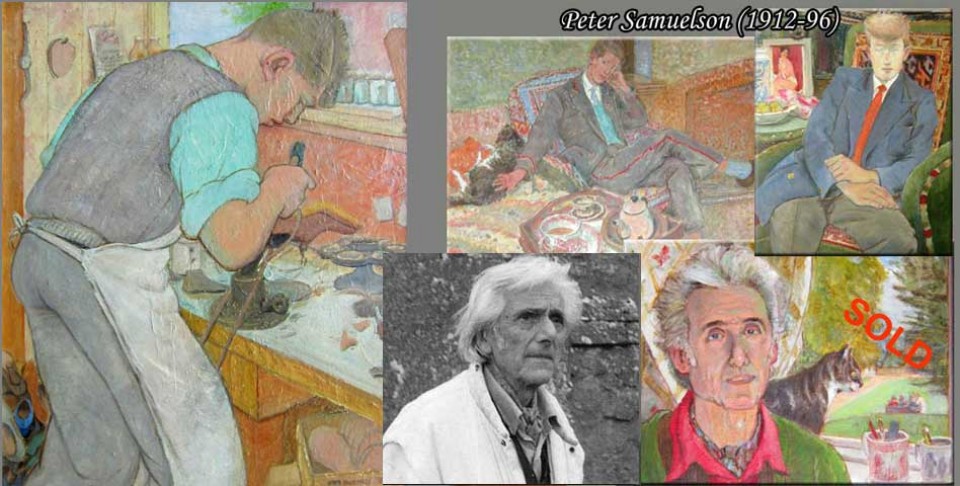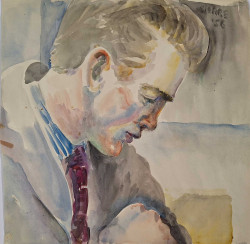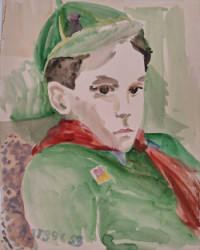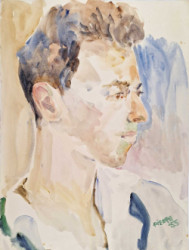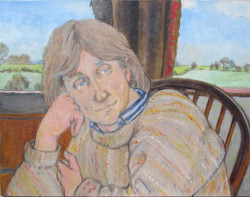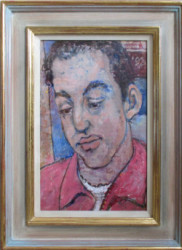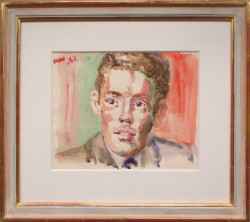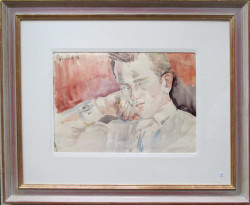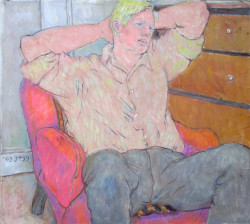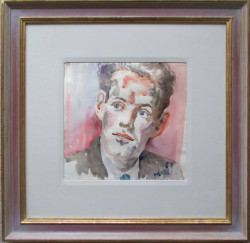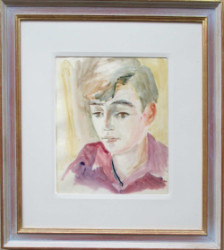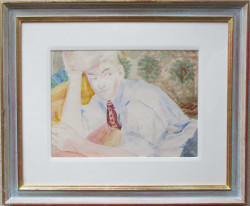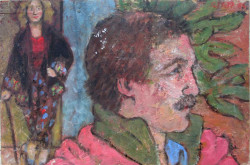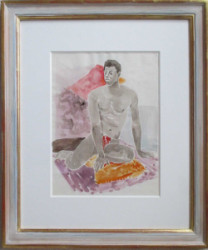Peter Samuelson (1912-96) was an artist to his finger tips. He could not be in a room with a piece of paper and pen without sitting down and sketching. The son of a rich hotelier, he was sent to Eton where his talent for art was recognized and encouraged.
In the 1930's - after art school - he lived in France for a time gradually developing a unique style. After World War II (in which he served as a soldier) he returned to London, had a short-lived marriage (which produced two children) before recognising his primarily gay nature. From then until the late 1960's he bought and lived in large 19th century London houses, which he filled with short-term tenants who often became the models for his artwork.
Because he came from a wealthy background and had a regular income, he never needed to work. An unfortunate result was that he didn't need to sell his work and never bothered to find a gallery to exhibit it. Apart from occasional sales to friends and a few gifts to models, most of the work remained unframed in his studio. When his health began to decline, the work was distributed among friends, who recognised his talent, and they began to place his work with galleries. As a result his reputation began to grow. In the 1980's The Gays Men's Press produced a small book about his work called "Post-War Friends" which began the consolidation of his reputation.
His work is so characteristic of the period immediately after the Second World War that the Bridgman Art Library selected it as representative of the age. Samuelson was a prolific painter. His subject matter was varied and not limited to the male form in art. Many of his painting are in fine collections. As well as painting he was addicted to drawing. Please check out the pages of his drawings on this website.
MORE ON PETER SAMUELSON -from an upcoming book by Paul Taylor
Peter Samuelson - An Enigmatic Artist
My lodgings were at 22 Upper Phillimore Gardens, W.8. Peter owned two floors of the stucco-fronted white house. The drama school was nearby, at the corner of Cromwell Road and Earls Court Road; the Studio Theatre was in Logan Place.


Peter Samuelson - a sacred drawing by Coral Polge
The Samuelson household was like a pasha’s den, piled with oriental carpets and kelims. A Shirvan kelim hung over the bedroom door at the end of my passage. I had been transported by a magic carpet from my Lancashire council house to an Oriental artistic den. It evoked the Islamic blue tiling and indoor fountains of Lord Leighton’s Holland Park studio; indeed, aspects might even have suggested the splendours of Sarah Bernhardt's Paris studio. On the walls of this seductive place were Peter’s inspired paintings, as yet unvalued and unknown. Peter was self-educated and a linguist, speaking Dutch, German, and French. He was a lover of Proust and read the whole of Remembrance of Things Past three times, once in French - A la Recherche du Temps Perdu. Was he also in search of lost time? From his wealthy Jewish background he bore a Cocteauesque charisma and cut a tall, distinguished figure. His grandfather, Baronet of Banbury, owned a few small factories in the area and sat in the House of Lords. Peter had been to Eton but intensely disliked it.
He had been married, and had three children: Bridget who lived upstairs, Serafina who lived in Holland, and Jean-Paul, who emigrated to Australia. Peter frowned upon the artistic community of “queers” and preferred the company of working class people. He drew and painted Ray the Butcher, John the Postman, and Tony the Milkman. His way of life reacted to the pretensions of class that had infused his upbringing. This kept him out of the art establishment, which seemed at the time to recognise only portraits of aristocracy and the famous. Peter's paintings of unknown men and women nevertheless displayed great panache, style and skill.
In the room next to mine lived Salim, a young Indian art student, vibrant and extrovert. His Queen’s English was exquisite. Upstairs, Michael Rothwell the actor gave “camp” audiences, declaring his passion for Poulenc. From his gramophone flowed luscious musical flavours interspersed with juicy theatrical gossip. He played Rodrigo at the Old Vic, in Laurence Olivier’s famous performance of Othello –one of the last to be played by a white man.
My entry into this world changed my life. To begin with it pushed me back, for I felt sometimes overwhelmed and inadequate. As the wit flowed, I had nothing to say. Awkwardly I put my foot in it, said the wrong thing and was ticked off. Feeling provincial and out of my depth, I relished the beauty of my new home’s interior and the lively discussions over meals. Peter played with me the game of “guess the composer” whose music was playing on Radio 3, or to identify the tribal rug from Turkey or the Caucasus. Around Peter, hundreds of magic carpets materialised out of the air: Yuruks, Ghiordes, Bergama, Ladik and Mudjur from Turkey; Eagle Star and Karatchoph from Kazakstan. In our games of "guess the rug" we relished a rotation of Talish, Shirvan and Daghestan prayer rugs. The colours spoke to my senses and soul: the natural vegetable dyes and beautiful designs harmonising with the quintessential proportions of the Tree of Life.
Peter became my first mentor outside the school system. During my textile education he would reprimand me and put me in my place. My theatrical ambition, arrogance and youthful attractiveness often irritated him. He said, “You’re becoming tiresome,” and asked me to leave. I didn’t feel rejected but complied with his wishes and went to my room: I always wanted to learn, and respected older people's knowledge and experience. Unusual and intriguing persons passing through took tea while Peter restored the rugs draped over his legs. They fell in patterns of cascading colours which hypnotized my senses. Peter was eccentrically interesting and interested in others; drawings appeared of male and female nudes from the life-class. His quality of line and character was delicate, precise, and intimate. My love and appreciation of ancient textile art and classical music developed in this erotic, sensual environment. My friendship with Peter lasted for 35 years until his death in 1996.

